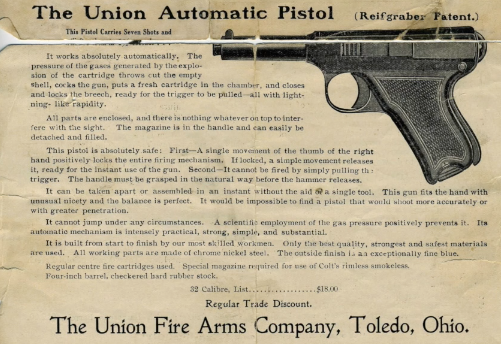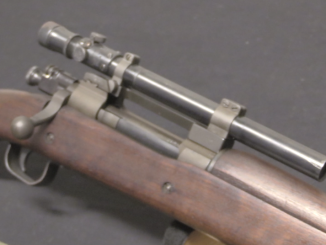We have all seen plenty of sporter CETME rifles and civilian HK-91s, but when the G3 was new to the Germany military, there was already na interest in bringing semiauto versions into the US. The Golden State Arms Corporation was the first to do so, with three batches of imports in 1962 (just 3 years after the G3 was adopted). The first of these came into the US in March, and was basically identical to the military G3 except with a two-position semiauto-only fire control pack.
Later imports had to be made more and more distinct from the military G3s, which leaves these 3/62 guns as the closest thing to the real G3 available to the non-NFA US shooter.




Hm…. I never really had a problem with the antibounce spring, even when the bolt is all greased up.
Nice to see a G3 with wood handguard and stock.
H&K. Why? Because you suck and we hate you.
G3s blow goats.
Totally agree. Ergonomics from Hell !
And a trigger like a cap pistol.
The HK G 3 is a 1940s based design that was intended to cheap, quick to produce and be somewhat reliable for what is a disposable weapon. It’s the AK 47 of the “Free World”. It can not be denied that when properly manufactured and maintained they will work. The rear sight is both poorly designed and limits the useful range of the 7.62 cal weapons. It’s the Lego set of military rifles. Pop off a stock, just fit a sliding collapsing stock; want a ” Sniper Rifle” snap on the detachable optic and take care not to bend the upper receiver.The trigger assembly can be changed by pushing out some pins and installing the desired one. Hell they even made a belt fed SAW out of the G3 (a beast to fire) The cocking knob is way too far forward for easy use.The G3 rifles in use today unless newly made in Iran or Pakistan are worn to the point that they offer little advantage over the AKM. Sorry HK fanboys but this design is yesterday’s news.
I think the G3 rear sight is a fairly good practical battle sight for real combat… It does limit the maximum effective range somewhat, but with the kind of combat it was designed for (i.e. large scale symmetric warfare with loads of support weaponry from GPMGs to heavy arty and air strikes) that would have probably not been a huge deal. Under combat duress most individuals would be hard pressed to hit hostile and often moving targets with iron sights much beyond 400 meters in any case.
You are correct, most people can not see a moving human at 400 meters. My complaint with the G 3 rear sight is that in my experience it tends to move with the vibrations of the mechanism. It just may be that I have only handled really beat up examples or “humped up” Semi Auto only models for the US market. I agree it is practical and it’s better than most AK platforms for real world applications. I prefer the FAMAS or the AR 15 or the underrated FN 2000 as a “practical’ rifle
I agree that the G3 is old tech and there would be very little reason for any country to adopt a G3 variant today. The Germans seemed to agree when they passed the G41 for the G36, although price seems to have been one of the reasons; apparently the G41 was more expensive than the G36 despite having a simpler operating system…
Back in the 1980s, g3s doctored to semi auto and 91s were ridiculously expensive.
Infact, all H&K stuff was hideously expensive.
The UK importer for H&K was also very reticent about allowing me to even touch one of his display pieces.
Seeing Ian disassemble that one, I really am wondering what the fuss was about.
Back at the time there were far better rifles available in Britain for much less money; FALs various garand and semi auto M14s, AR10s…
“Back at the time there were far better rifles available in Britain for much less money; FALs various garand and semi auto M14s, AR10s…”
So it basically was paying for H&K sign on fire-arm, not fire-arm itself.
Exactly! Very well said.
I’m not sure what the price was on these, (this is as described, a “ghost gun,” and the first I’ve ever seen), but the CETME rifles that sold at roughly the same time were a little over $200.00 U.S. As a comparison, you could get a nice Weatherby rifle in one of their lower grades for less than $100.00, and a top flight custom hunting rifle could be had for a bit over $200.00. I’m going to guess that these are “rare” for that reason.
The typical Santa Fe branded SMLE “Jungle Carbine” and related “sporters” sold for about $30.00 U.S.
Why did AR-15/M-16s go to all that trouble with spring loaded plunger detents to keep the pins in place, yet this rifle has none? Can one shoot them loose?
They do have springs integral to the pins. They are hard to see, but they are basically little hooks on the pins themselves that provide some interference when the pins are inserted.
Interesting that these are G3A2-based, whereas all subsequent models were based on the G3A3 with the “free-floating” barrel.
Person I knew back in the late 1980’s had one he brought back from Germany after service there. It was fun to shoot. Every time we went to a gun show and he saw the parts and instructions to make it full auto he would be like, temptation get behind me.
As a former Californian who has moved to Arizona, I can’t help but smirk when I hear/read the name: “Golden State Arms Corp. of California”.
For decades now it has been “The Tarnished State” and as we all know, the status of gun-owners in California is in serious question.
Argh! Cheese! If only this were in production today at an affordable price near my hometown… Too bad the anti-gun liberals seem to yell about gun violence and it turns out that the guns were smuggled into town, not made in town…
I didn’t know the paddle release was the original design, always thought that was a later improvement. That brings the G3 back up a few points in my mind, much better system than a button sort of frustratingly out of reach.
Got admit it seems like a case of double-dealing here, a paddle release like an AK, AND a button release like an AR-15?
I suspect it was intended for export to the Second and Third World. Troops trained on an AK would instinctively reach for a paddle release, those trained on an M1 Carbine would reach for a button.
Those trained on a Garand would probably find the whole thing a bit silly. After all, a proper rifle ejects its own empty clip and leaves the bolt open for you to shove a full one in.
It can also efficiently kill an enemy at 1000 yards. Something the rest can’t even get close to doing.
cheers
eon
Good luck seeing- let alone hitting- your target at 1000 yds. Now, try that with a target that isn’t to keen on the idea of being shot, is likely moving, and has plenty of friends and support weapons that are trying to eliminate you.
The Garand is capable of delivering suppressive fire out to 1000 yards even with iron sights, which is something the G3 or AK can’t really do. How significant that would be depends on the situation. I agree that in most cases it would not make any difference, but for counter-insurgency combat in a place like Afghanistan it might sometimes be useful. Optimally, of course, suppression at such ranges would be handled by your GPMG or other suitable light support weapons, such as 60mm mortars.
AFAIK, the “Santa Fe Division” of Golden State Arms Corporation was a just a seller of rebuilt military surplus guns. Many a SMLE was “sporterized” and then sold by this company. Golden State bought tons of surplus in various states of decay and would dress it up and sell it to the public here in the U.S. through this Santa Fe Division.
Can anyone point me to a contemporary review or advertisement for these “Santa Fe Division” G3’s?
Remember the Golden State ” Jungle Carbines ” in those halcyon days of the 60s ?
Oh yes, the infamous “Jungle Carbine” … sheesh.
They still come into the shop occasionally. The condition under the wood is often a sight to see. Those folks at Golden State had quite the little cottage industry going. My guess is that they had about 30 cents into each gun that they sold for $30. ^__^
Ian I just watched a vid where you considered the G3/91 series very overrated. I guess this one was worth doing a review on being the first one imported into the U.S.
Hello Ian
The two big pins are going in to the two holes in the stock, the small ones back in to the orignal position so you don’t loes them in the field. And a field strip you remove the bolt head and go dowen to the fiering pin. At least that was it during my time at the Bundeswehr.
The easy way to reset the rollers is to insert the bolt and bolt carrier into the receiver backwards, you meet a point of resistance and you only need to apply a little pressure and the bolt stretches forward and is reset. I saw my first HK rifle in Thailand in 1974. There was martial law and a soldier on every street corner. Some of them had HK33 rifles, I was fascinated to learn that they were made there in Thailand. It wasn’t until 1985 that I could afford my own HK rifle, German made with a free float barrel and bipod for $500 and the PSG1 FCG for $127. With the right ammo it will print 3 shots in ½ MOA. It is a heavy rifle, I wouldn’t want to carry it all day, but it shoots the same bullet as the M60 or M240B and weighs about half as much. When FAC tested their sand cast aluminum receiver, we shot 17,000 rounds through 1 test rifle during 1 weekend with no broken parts, only a few quick cleanings. How many rifles can do that? The bent sheet metal receiver is better/stronger, but we proved that AR15 tech could be applied to other designs.